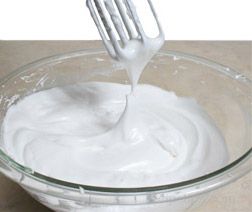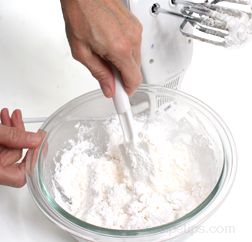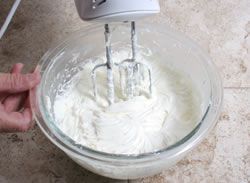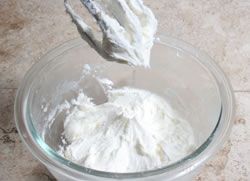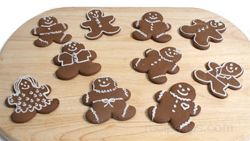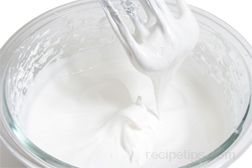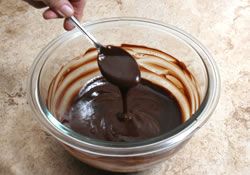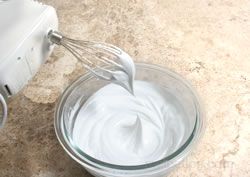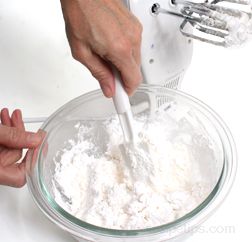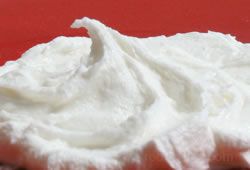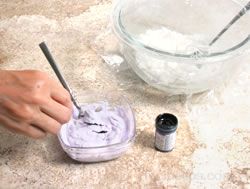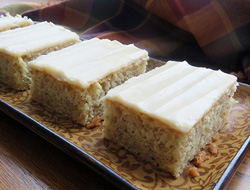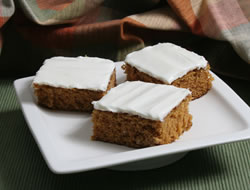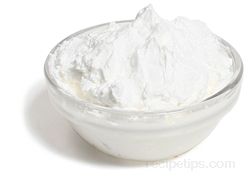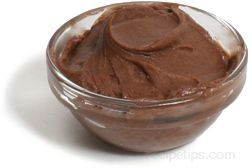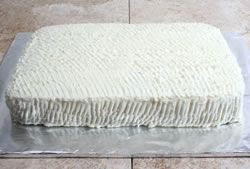Frosting Types |
|
Boiled Frosting
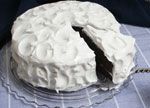 Boiled frosting is a white fluffy topping that is made without any type of fat added. Most of its ingredients are cooked until they come to a boil and are then boiled for a period of time. The boiled mixture is then slowly mixed into beaten egg whites until the icing is light and fluffy. Some boiled frosting recipes are a little sticky and sets up fairly quickly so they need to be spread as soon as the frosting is made, while others will remain workable without having to worry about it setting up. See How to Make Boiled Frosting. Boiled frosting is a white fluffy topping that is made without any type of fat added. Most of its ingredients are cooked until they come to a boil and are then boiled for a period of time. The boiled mixture is then slowly mixed into beaten egg whites until the icing is light and fluffy. Some boiled frosting recipes are a little sticky and sets up fairly quickly so they need to be spread as soon as the frosting is made, while others will remain workable without having to worry about it setting up. See How to Make Boiled Frosting.
|
|
Uses
It is mostly used in cake decorating as an overall frosting layer that can be spread smoothly over the surface of the cake or it can be given a simple frosting design such as swirls or peaks. It can be used for some basic piping, such as borders or writing but, because it so light and fluffy and can be slightly sticky, it is a little harder to work with when decorating a cake or cupcakes. |
Storage
It is best if used as soon as it is made but if necessary it could be stored for a day. Be sure to cover tightly and then refrigerate. If it is not stored airtight, it will begin to set. Once a cake has been frosted with boiled icing it can be stored at room temperature but refrigerating will help keep the frosting soft and fluffy longer. Freezing is not recommended. |
|
Buttercream Frosting
 A soft, creamy frosting made with powdered sugar and butter or shortening or a combination of both. It will have a slightly off white color when butter is used and if brown vanilla is used for flavoring. The butter provides a delicious flavor to the frosting and because of its soft texture, it is easy to cut. Buttercream is a good frosting for decorating with a pastry bag. It works well for many different designs because the frosting consistency can be thickened or thinned when necessary to make it workable for the type of design you are working with. A soft, creamy frosting made with powdered sugar and butter or shortening or a combination of both. It will have a slightly off white color when butter is used and if brown vanilla is used for flavoring. The butter provides a delicious flavor to the frosting and because of its soft texture, it is easy to cut. Buttercream is a good frosting for decorating with a pastry bag. It works well for many different designs because the frosting consistency can be thickened or thinned when necessary to make it workable for the type of design you are working with.
There are different varieties of buttercream frosting, such as meringue buttercream and rolled buttercream that have different characteristics than basic buttercream frosting and will give the cake a different appearance and taste. |
|
Uses
Buttercream is used for many cake recipes and is has many different decorating uses. It can be used for making flowers and many other shapes as well as for borders and writing. Buttercream frosting made with butter or margarine does not hold up well when exposed to warm temperatures. If you know the cake will be exposed to warm temperatures, such as for an outside summer wedding, it is best to use shortening in the frosting because it will hold up better. Buttercream can be used on cakes, cupcakes, and cookies. |
Storage
Buttercream frosting can be stored, refrigerated, in an airtight container for up to 2 weeks before using. Remove it from the refrigerator at least an hour before using so it will warm to room temperature. It can also be frozen for extended storage. A decorated cake with buttercream frosting can be stored at room temperature for up to 3 days. If you want to refrigerate a decorated cake, place it in the refrigerator unwrapped until the frosting hardens slightly. It can then be loosely covered with plastic. |
|
Cream Cheese Frosting
|
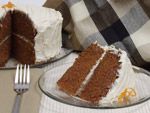 Cream cheese frosting is basically the same as buttercream frosting with the addition of cream cheese. It is rich and creamy and makes a great frosting for many cake recipes. Carrot cake recipes most often suggest frosting the cake with a cream cheese frosting. Cream cheese frosting is basically the same as buttercream frosting with the addition of cream cheese. It is rich and creamy and makes a great frosting for many cake recipes. Carrot cake recipes most often suggest frosting the cake with a cream cheese frosting.
|
| Cream cheese frosting does not make a good frosting for decorating a cake because it is too soft. Because of its rich taste and creamy texture it is also a popular frosting for cupcakes, bars, and cookies. |
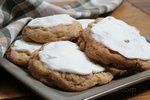 | |
|
Uses
It is great for frosting a cake or for using as a filling. Because of its soft texture it does not make a good frosting for making decorations because it will not hold up. It is great on banana cake, carrot cake, and spice cakes. Also, used on many bars and cookies. |
Storage
Cream cheese frosting can be stored in the refrigerator for up to 2 weeks before using. Cakes frosted with cream cheese frosting must be stored in the refrigerator. The frosting will firm up when chilled but will soften quickly when it sits at room temperature. |
|
Dusting
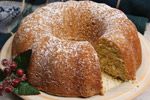 Dusting is generally a coating of powdered sugar or cocoa powder that is applied to a cake or cupcakes after they have cooled. It can also be applied over the frosting for certain effects. A light dusting can be applied by using a sifter, sieve, or dredger. Dusting is generally a coating of powdered sugar or cocoa powder that is applied to a cake or cupcakes after they have cooled. It can also be applied over the frosting for certain effects. A light dusting can be applied by using a sifter, sieve, or dredger. |
| The coating is sometimes applied as an all over dusting and sometimes a stencil is used to create a design. Other ingredients that can be used for dusting include: cinnamon; cinnamon and sugar; colored sugar; and finely chopped nuts. |
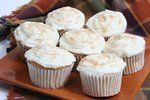 | |
|
Uses
Uses
Dusting can be used on any type of cake that you do not want to frost. It is also used on cupcakes and brownies. Some people consider frosting too sweet and would prefer their cake without frosting. Dusting is a good method to use to decorate the cake without adding much sweetness. It is also a good technique to use as an additional effect to frosted cakes. Use powdered sugar on chocolate or dark colored cakes, cupcakes, and brownies. Use cocoa powder or cinnamon on lighter colored cakes for the most dramatic effect. |
Storage
Many dusting ingredients are shelf stable items that should be stored accordingly. When applied to the cake, storage time should be followed as to what is appropriate for the type of cake. When using powdered sugar for dusting, it is a good idea to wait to dust the item just before serving because it can absorb the sugar, especially if it is a moist cake, cupcake, or brownie. |
|
Fondant
 Rolled fondant icing is a pliable dough made from gelatin, glucose, glycerin and powdered sugar. Flavoring is also added to the fondant. The dough is kneaded until it is smooth and pliable. It is then rolled into a thin sheet of icing that is used to cover a firm variety cake. The sheet of fondant is place over the cake so that it will cover all sides and is then smoothed on the top and sides. Generally the cake is first covered with a coating of buttercream frosting, marzipan, or apricot glaze to seal in moisture to help keep the cake fresh before the fondant is place on it. The fondant gives the cake a smooth, elegant, matte finish that is great for wedding cakes. It provides a nice smooth finish that is great for decorating with other frostings. The rolled fondant can also be used to make leaves, flowers, and other designs to apply to the cake. Rolled fondant icing is a pliable dough made from gelatin, glucose, glycerin and powdered sugar. Flavoring is also added to the fondant. The dough is kneaded until it is smooth and pliable. It is then rolled into a thin sheet of icing that is used to cover a firm variety cake. The sheet of fondant is place over the cake so that it will cover all sides and is then smoothed on the top and sides. Generally the cake is first covered with a coating of buttercream frosting, marzipan, or apricot glaze to seal in moisture to help keep the cake fresh before the fondant is place on it. The fondant gives the cake a smooth, elegant, matte finish that is great for wedding cakes. It provides a nice smooth finish that is great for decorating with other frostings. The rolled fondant can also be used to make leaves, flowers, and other designs to apply to the cake.
|
|
Uses
Fondant can be used on any firm cake that a smooth surface is desired. It is great for wedding cakes and other special occasion cakes. Fondant has become a very popular choice when decorating cakes. It holds up in warm temperatures fairly well but will soften slightly when exposed to extreme heat. |
Storage
Unused fondant can be stored in an airtight container for up to 2 months at room temperature in a cool, dry area. Do not refrigerate or freeze. Store cakes decorated with fondant for up to 3 days at room temperature. |
|
Fresh Fruit Topping
 Fresh fruit can also be added as a topping to the cake. A cake with fresh fruit topping should only be assembled within a few hours of eating it. The fruit continues to ripen even when refrigerated and its juices will begin to soak into the cake. This Flag Cake has been decorated with blueberries and strawberries. Fresh fruit can also be added as a topping to the cake. A cake with fresh fruit topping should only be assembled within a few hours of eating it. The fruit continues to ripen even when refrigerated and its juices will begin to soak into the cake. This Flag Cake has been decorated with blueberries and strawberries.
|
|
Uses
Fresh fruit is used to add lots of flavor and color to a cake. Fruits, such as strawberries, raspberries, blueberries, peaches, and kiwi all add a lot of great flavor; they also add a lot of color, each on their own or combined together for multiple colors. |
Storage Note:
If the cake has a cooked fruit topping that does not contain eggs, it can be stored at room temperature for up to 2 days. Refrigerate for longer storage. If the cake is going to be frozen, it is best to wait until the cake is thawed and then add the fresh fruit topping just before it is going to be served. |
|
Ganache
 A rich chocolate mixture made of chocolate and heavy cream. Dark chocolate is generally used but milk or white chocolate can also be used. The cream is heated to a boil and then poured over the chopped chocolate. The cream and chocolate are stirred together until smooth. This mixture is then allowed to cool until it is just barely warm and is then poured over the cake. The ganache dries to a semi-hard coating. The mixture can also be cooled and then whipped until it is a fluffy texture, which can then be spread on the cake as a frosting. Ganache can also be used as a cake filling. A rich chocolate mixture made of chocolate and heavy cream. Dark chocolate is generally used but milk or white chocolate can also be used. The cream is heated to a boil and then poured over the chopped chocolate. The cream and chocolate are stirred together until smooth. This mixture is then allowed to cool until it is just barely warm and is then poured over the cake. The ganache dries to a semi-hard coating. The mixture can also be cooled and then whipped until it is a fluffy texture, which can then be spread on the cake as a frosting. Ganache can also be used as a cake filling.
|
|
Uses
Ganache is most often poured over a layered cake or bundt cake similar to a glaze to provide a coating to the cake. It is used as a filling, a glaze or is whipped and used as a frosting. It is best not to use where it will be exposed to warm temperatures because it will soften. |
Storage
Ganache can be stored at room temperature for up to 2 days before using. If storing, be sure to cover the entire surface of the ganache. Cover with plastic wrap. Press it down so that it is covering the entire surface completely. The ganache will need to be warmed again before using. A cake covered with ganache should be stored at room temperature. If it is exposed to warm temperatures, it will begin to soften. |
|
Glaze and Syrup
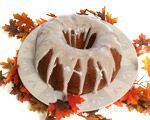 A glaze is a thin coating made from powdered sugar and liquid, whereas syrup is made from granulated sugar and liquid. Both glazes and syrups may have other ingredients added for flavoring. Glazes are generally spread, drizzled, or poured on the cake, depending on the consistency of the recipe. They do not always cover the entire cake. Many times the glaze or syrup will only drizzle down the sides of the cake. A glaze is a thin coating made from powdered sugar and liquid, whereas syrup is made from granulated sugar and liquid. Both glazes and syrups may have other ingredients added for flavoring. Glazes are generally spread, drizzled, or poured on the cake, depending on the consistency of the recipe. They do not always cover the entire cake. Many times the glaze or syrup will only drizzle down the sides of the cake.
|
|
Uses
They are used to garnish bundt style cakes, Angel Food cakes, and other foam or sponge type cakes but a glaze or syrup coating also adds moisture and flavor to the cake. Glazes and syrups are also sometimes used on quick breads and sweet rolls, such as cinnamon rolls. |
Storage
If a glaze will set at room temperature for a while before being used, it should be kept loosely covered and if it begins to thicken set it in a pan of warm water to help loosen. A glaze can be frozen but its sheen will not be the same and it will need to be reheated. A cake with a glaze or syrup coating should not have to be refrigerated unless the cake has a filling that requires refrigeration. Allow the glaze to cool and harden completely before covering the cake for storing. |
|
Gum Paste - Sugar Paste
Gum paste and sugar paste are basically the same product. It is made from sugar dough that generally contains a gum agent, such as gum tragacanth. It has the texture of molding clay and works great for making flowers and other delicate designs. It is stronger than fondant and easier to work with. It can be rolled out very thin and used to make very intricate designs. When it dries it is hard and can be stored for a long time. The decorations made from gum paste are edible but not very tasty. |
|
Uses
It is easy to mold and work with to make delicate flowers, figures, and animals. The paste can be rolled out very thin and it remains still very workable. The shapes can be created by hand on a separate surface, dried, and then placed on the cake or cupcakes. This is helpful when you have a lot of decorations that need to be made because you can begin making them ahead of time and apply them when you are ready to finish decorating. |
Storage
Unused paste can be stored in an airtight container, not refrigerated, for up to 2 months but be sure the container is closed tight so it does not harden. Do not freeze. Decorated cake can be stored at room temperature for up to 3 days. The gum paste will hold up fairly well on warm days but extreme heat will start to soften the paste. |
|
Meringue-Style Frosting
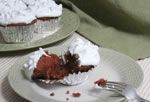 Meringue-style frosting is made from whipped egg whites, sugar, and other ingredients that produce a fluffy but very dense consistency topping. Its flavor changes according to the ingredients that are add to the egg whites and sugar. Unless baked, the meringue-style frosting has a tendency to deflate easily. They should be made as close to serving as possible. Meringue-style frosting is made from whipped egg whites, sugar, and other ingredients that produce a fluffy but very dense consistency topping. Its flavor changes according to the ingredients that are add to the egg whites and sugar. Unless baked, the meringue-style frosting has a tendency to deflate easily. They should be made as close to serving as possible.
|
|
Uses
Goes well with most types of cake. Its light and fluffy texture blends well with fruit. |
Storage
Does not store well, deflates easily. Recommended to prepare close to when it is to be used. If storing, it needs to be refrigerated. |
|
Powdered Sugar Frosting
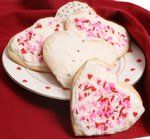 Powdered sugar frosting is a very versatile frosting in that it can be made thick for detail decorating or thinned down and used as a glaze. It is easy to tint and adjust the consistency so it works well for decorating. It is often used for decorating cookies because when it dries the surface will form a thin crust, which allows the cookies to be stacked slightly when stored. Powdered sugar frosting is sometimes flavored with different extracts to change its flavor slightly. Common flavorings used are vanilla, almond, lemon, and peppermint. Powdered sugar frosting is a very versatile frosting in that it can be made thick for detail decorating or thinned down and used as a glaze. It is easy to tint and adjust the consistency so it works well for decorating. It is often used for decorating cookies because when it dries the surface will form a thin crust, which allows the cookies to be stacked slightly when stored. Powdered sugar frosting is sometimes flavored with different extracts to change its flavor slightly. Common flavorings used are vanilla, almond, lemon, and peppermint.
|
|
Uses
It is often used for decorating cookies but work well for bars, cupcakes, and cakes. |
Storage
To keep the frosting soft, store it in an airtight container at room temperature. If stored uncovered it will form a crust over the surface and evidentially dry out. If the item frosted with powdered sugar frosting needs refrigeration, it should be stored covered in the refrigerator. |
|
Royal Icing
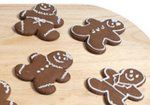 Royal icing is made with powdered sugar and egg whites or meringue powder. The royal icing works great for decorations that need to last a long time because it dries very hard. It has a nice white color and works well for piping lines and shapes. Some Royal icing recipes lack in flavor and are hard when dry so some are not the best choice for an edible frosting. Royal icing is made with powdered sugar and egg whites or meringue powder. The royal icing works great for decorations that need to last a long time because it dries very hard. It has a nice white color and works well for piping lines and shapes. Some Royal icing recipes lack in flavor and are hard when dry so some are not the best choice for an edible frosting.
|
|
Uses
Royal icing dries quickly so it works good when working with delicate designs. It flows easily so it works well for writing, piping, and outlining. Can be used on cakes, cupcakes, and cookies. Also works well for decorating gingerbread houses.
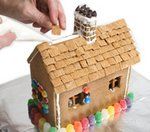
|
Storage
Royal icing has a tendency to dry fairly quickly so it is important to take precautions while using it so it does not dry out before you are finished. It can be stored up to 3 days at room temperature. Be sure to cover the icing in the bowl with a damp cloth and then plastic to prevent it from drying out. The icing may separate slightly but a good stirring will bring it back to a smooth texture. The royal icing on a cake does not require refrigeration. If the cake needs to be covered, the royal icing will be hard so you do not have to worry about disrupting the decorations. |



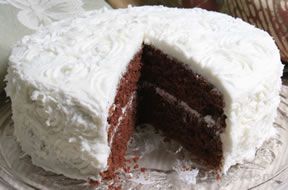


 Boiled frosting is a white fluffy topping that is made without any type of fat added. Most of its ingredients are cooked until they come to a boil and are then boiled for a period of time. The boiled mixture is then slowly mixed into beaten egg whites until the icing is light and fluffy. Some boiled frosting recipes are a little sticky and sets up fairly quickly so they need to be spread as soon as the frosting is made, while others will remain workable without having to worry about it setting up. See
Boiled frosting is a white fluffy topping that is made without any type of fat added. Most of its ingredients are cooked until they come to a boil and are then boiled for a period of time. The boiled mixture is then slowly mixed into beaten egg whites until the icing is light and fluffy. Some boiled frosting recipes are a little sticky and sets up fairly quickly so they need to be spread as soon as the frosting is made, while others will remain workable without having to worry about it setting up. See  A soft, creamy frosting made with powdered sugar and butter or shortening or a combination of both. It will have a slightly off white color when butter is used and if brown vanilla is used for flavoring. The butter provides a delicious flavor to the frosting and because of its soft texture, it is easy to cut. Buttercream is a good frosting for decorating with a pastry bag. It works well for many different designs because the
A soft, creamy frosting made with powdered sugar and butter or shortening or a combination of both. It will have a slightly off white color when butter is used and if brown vanilla is used for flavoring. The butter provides a delicious flavor to the frosting and because of its soft texture, it is easy to cut. Buttercream is a good frosting for decorating with a pastry bag. It works well for many different designs because the  Cream cheese frosting is basically the same as buttercream frosting with the addition of cream cheese. It is rich and creamy and makes a great frosting for many cake recipes. Carrot cake recipes most often suggest frosting the cake with a cream cheese frosting.
Cream cheese frosting is basically the same as buttercream frosting with the addition of cream cheese. It is rich and creamy and makes a great frosting for many cake recipes. Carrot cake recipes most often suggest frosting the cake with a cream cheese frosting.
 Dusting is generally a coating of powdered sugar or cocoa powder that is applied to
Dusting is generally a coating of powdered sugar or cocoa powder that is applied to 
 Rolled fondant icing is a pliable dough made from gelatin, glucose, glycerin and powdered sugar. Flavoring is also added to the fondant. The dough is kneaded until it is smooth and pliable. It is then rolled into a thin sheet of icing that is used to cover a firm variety cake. The sheet of fondant is place over the cake so that it will cover all sides and is then smoothed on the top and sides. Generally the cake is first covered with a coating of buttercream frosting, marzipan, or apricot glaze to seal in moisture to help keep the cake fresh before the fondant is place on it. The fondant gives the cake a smooth, elegant, matte finish that is great for wedding cakes. It provides a nice smooth finish that is great for decorating with other frostings. The rolled fondant can also be used to make leaves, flowers, and other designs to apply to the cake.
Rolled fondant icing is a pliable dough made from gelatin, glucose, glycerin and powdered sugar. Flavoring is also added to the fondant. The dough is kneaded until it is smooth and pliable. It is then rolled into a thin sheet of icing that is used to cover a firm variety cake. The sheet of fondant is place over the cake so that it will cover all sides and is then smoothed on the top and sides. Generally the cake is first covered with a coating of buttercream frosting, marzipan, or apricot glaze to seal in moisture to help keep the cake fresh before the fondant is place on it. The fondant gives the cake a smooth, elegant, matte finish that is great for wedding cakes. It provides a nice smooth finish that is great for decorating with other frostings. The rolled fondant can also be used to make leaves, flowers, and other designs to apply to the cake.  Fresh fruit can also be added as a topping to the cake. A cake with fresh fruit topping should only be assembled within a few hours of eating it. The fruit continues to ripen even when refrigerated and its juices will begin to soak into the cake. This
Fresh fruit can also be added as a topping to the cake. A cake with fresh fruit topping should only be assembled within a few hours of eating it. The fruit continues to ripen even when refrigerated and its juices will begin to soak into the cake. This  A rich chocolate mixture made of chocolate and
A rich chocolate mixture made of chocolate and  A glaze is a thin coating made from powdered sugar and liquid, whereas syrup is made from granulated sugar and liquid. Both glazes and syrups may have other ingredients added for flavoring.
A glaze is a thin coating made from powdered sugar and liquid, whereas syrup is made from granulated sugar and liquid. Both glazes and syrups may have other ingredients added for flavoring.  Meringue-style frosting is made from
Meringue-style frosting is made from  Powdered sugar frosting is a very versatile frosting in that it can be made thick for detail decorating or thinned down and used as a glaze. It is easy to tint and adjust the consistency so it works well for decorating. It is often used for decorating cookies because when it dries the surface will form a thin crust, which allows the cookies to be stacked slightly when stored. Powdered sugar frosting is sometimes flavored with different extracts to change its flavor slightly. Common flavorings used are vanilla, almond, lemon, and peppermint.
Powdered sugar frosting is a very versatile frosting in that it can be made thick for detail decorating or thinned down and used as a glaze. It is easy to tint and adjust the consistency so it works well for decorating. It is often used for decorating cookies because when it dries the surface will form a thin crust, which allows the cookies to be stacked slightly when stored. Powdered sugar frosting is sometimes flavored with different extracts to change its flavor slightly. Common flavorings used are vanilla, almond, lemon, and peppermint. Royal icing is made with powdered sugar and egg whites or
Royal icing is made with powdered sugar and egg whites or 
